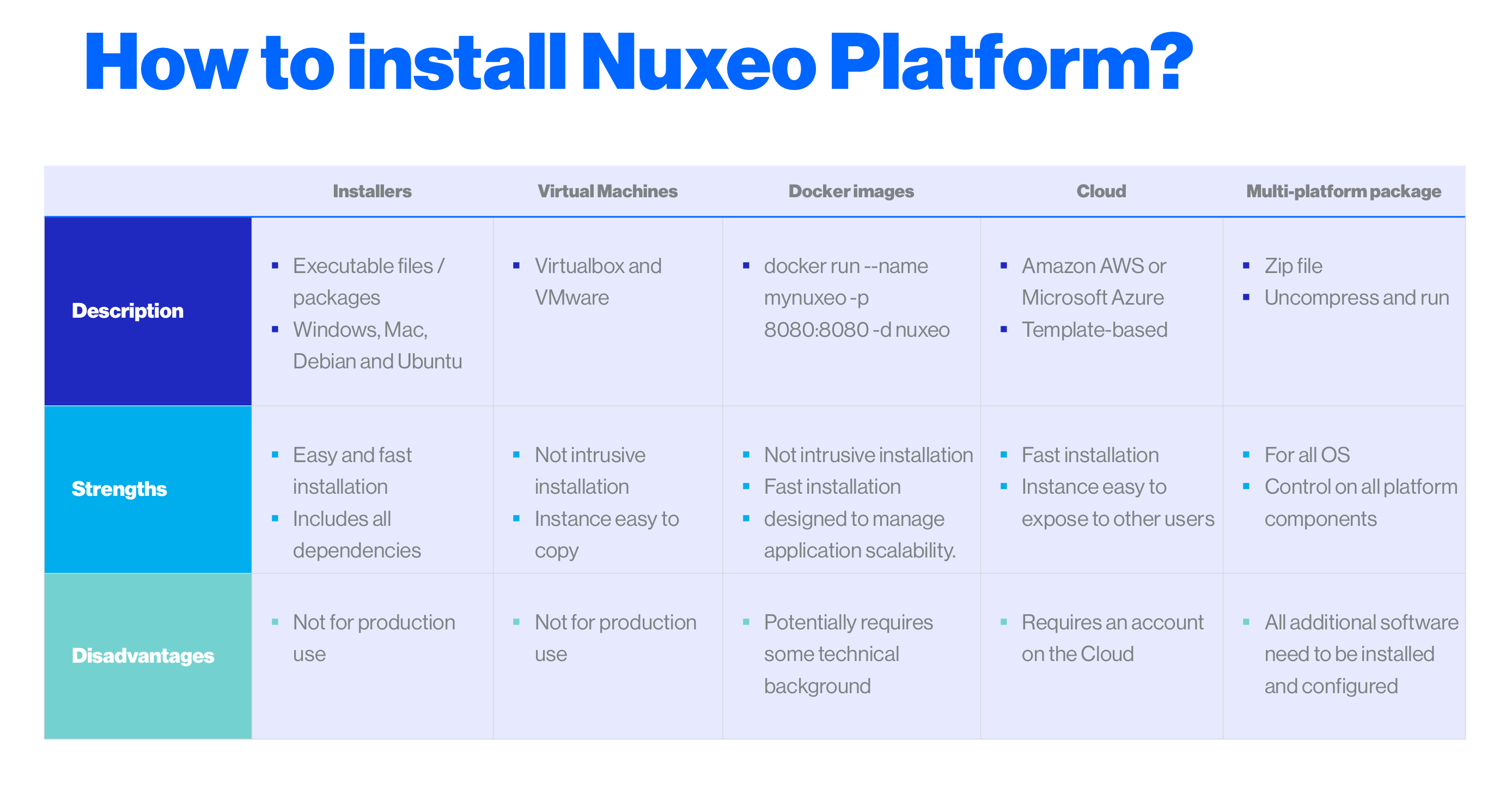The Nuxeo Platform comes in many different packages and can be installed on many operating systems. You may have to install:
- a zip archive (works on any operating system that supports a Java Development Kit),
- a Windows installer (.exe),
- a virtual machine image (works on any operating system that supports running VMware or VirtualBox),
- a .deb package (works on Linux Debian and Ubuntu).
General Installation Process
Installing the Nuxeo Platform requires a few steps:
- Have a look at our Hardware and Software Requirements in the section below, as well as our supported databases and application servers. You may also want to read our page regarding required storage space.
- Install and Set up the related software (unless you deploy on Amazon, the image already includes it).
- Install and start the Nuxeo Platform server. To understand how to start a Nuxeo Platform server on different environments, you can read and follow one of our recipes:
- Run the Configuration Wizard (not in the case of a standard static WAR).
Hardware and Software Requirements
The following table lists the current requirements for running the Nuxeo Platform.
If you have requirements and/or constraints are not reflected below, do not hesitate to contact the Nuxeo team to evaluate the feasibility of running Nuxeo on any other environment, be it a different JVM, Database, Application server or OS.
| Hardware Requirements | Minimum requirement to start a Nuxeo server:
|
Note: a production-ready setup for the Nuxeo Platform may require several servers and different hardware sizing, depending on your SLA and planned usage. Contact Nuxeo for more information and for assistance with sizing your production architecture. |
|---|---|---|
| OS |
|
Note: the only limitation on OS nature and version is the ability to install the correct version of the required JDK (see below). It means that while it is commonly reported to run on recent versions of Ubuntu, RHEL, Debian, CentOS, it can also run on any Linux distribution where it is possible to install the required JDK. You may have to adapt the provided startup shell scripts. |
| Java | JDK 8 and JDK 11 (Oracle's JDK or OpenJDK) | See the following documentation: |
| Application Server |
|
Nuxeo is shipped with an embedded Tomcat server. |
| Database |
|
Nuxeo Platform will likely work with greater versions of the aforementioned databases. Do not hesitate to inform Nuxeo support of your attempts with different versions.
More information can be found on the Database Configuration page. Note that Nuxeo Server is shipped with an embedded H2 database, for quick evaluation purposes. One of the listed databases is required for a production set up or for a more thorough evaluation, like performance testing. |
| Authentication and User Management | The Nuxeo Platform provides its own user and group directories and authentication solutions. It is also compatible with multiple cloud and enterprise solutions:
|
See Authentication and User Management section. |
| Optional Third-Party Software | Some third party software may be required depending on the conversions capabilities you want to benefit from. The following list is not exhaustive:
|
More information on installing third-party software. |
| Client-Side Requirements | The Nuxeo Platform comes with several applications for business users, which have their own requirements: |
Checking Your Java Version
To check that you have the right version of Java:
Open a terminal:
- On Linux or macOS: open a terminal.
- On Windows: press the "Windows" key + r, type
cmd(orcommand) in the Run window and press "OK" (or open the Command Prompt from Start > Programs > Accessories in Windows 7 or entering Command Prompt in Cortana in Windows 10)
Type
java -versionand press Enter. If Java is correctly installed on your computer, the name and version of your Java virtual machine is displayed:java version "1.8.0_112" Java(TM) SE Runtime Environment (build 1.8.0_112-b15) Java HotSpot(TM) 64-Bit Server VM (build 25.112-b15, mixed mode)Check in the output that the JDK version is 64 bits.
If Java is not installed on you computer, it will fail to display the Java version. In this case, install Java (see below).
If Java is installed but not included in the PATH, it will fail to find the Java command. In that case, you need to add
$JAVA_HOME/bin/to your PATH (see How do I set or change the PATH system variable?).To ensure you installed a Java Development Kit environment, type
javac -versionand press Enter.If you installed a JDK, the javac version is displayed:
javac 1.8.0_112If you installed a Java Runtime Environment instead of a Java Development Kit, it will fail to find javac and to display the javac version. In this case, install a Java Development Kit (see below).
Installing Java Development Kit
For Linux Users
sudo apt install openjdk-8-jdk
You can also download Java 8 from the Oracle website.
For macOS Users
Java packages and instructions for installation are available from the Oracle website:
For Windows Users
If the required version of Java is not installed on your computer:
- Download it from the Oracle website (Java 8) and choose the appropriate platform for your hardware and Windows version.
- Run the downloaded .exe file and follow the instructions displayed.
